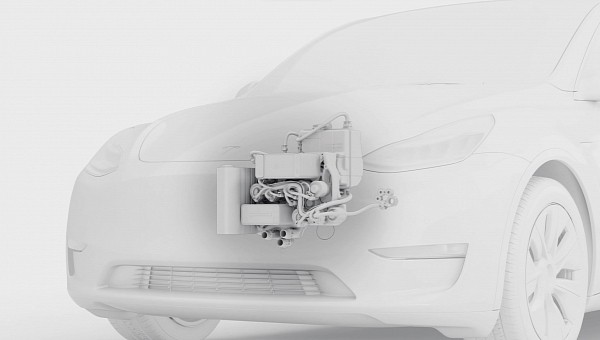Tesla shared a video explaining how its special-design heat pump was conceived and optimized, essentially reinventing the old heat pump concept. All Tesla cars are fitted standard with a heat pump which helps minimize waste in the thermal management system.
Electric vehicles need precise thermal management to operate efficiently, so they must regularly warm or cool their internals. These include the battery and the drive units, with the former especially sensitive to temperature changes. The battery can quickly heat under load, which is detrimental to its lifecycle. In the winter, a cold battery will not be able to deliver enough current to the motors, and charging would take a lot more on a cold battery.
This is why the battery thermal management system is extremely important. Traditionally, EVs used resistive heaters to generate heat when needed. This is inefficient because resistive heaters draw a lot of current, which can take a heavy toll on the battery, especially in very cold climates. A better way is to use a heat pump, which can harness residual heat to regulate the temperature efficiently. A heat pump is said to reduce energy consumption in winter by up to 25% compared to using resistive heaters, which is huge in an electric vehicle.
Tesla first introduced a heat pump with the launch of the Model Y, but is now offering it standard on all its vehicles. Tesla’s heat pump is an engineering wonder, as has been said many times before. The EV maker reinvented a century-old technology to install it inside the Model Y. It wasn’t without issues, though. Early Tesla Model Y cars suffered from teething problems because of the new heat pump. The parts that failed were the “super manifold” and the “octovalve,” both innovations introduced by Tesla with the new technology.
Eventually, Tesla fixed the issues last year, and we’ve never heard of such problems during this winter. Teething issues aside, Tesla’s heat pump is a marvelous piece of engineering that has been praised for its ingenuity. Tesla engineers have reduced the number of parts and, thus, the complexity of the heat pump. This resulted in the invention of the Super Manifold, which is basically a two-layer PCB assembly, as Tesla engineers explain in the video below.
It has all the refrigerant channels in the front, which would normally be separate components and pipelines connecting everything together. A similar approach is at the back with the coolant components, which are all plumbed together. The Super Manifold, thus, eliminates about 20 separate parts. The same approach was made to replace the controlling valves with a single assembly, which they called the “octovalve.”
The video shows the octovalve as a barrel that can activate different ports, depending on the requirements. It’s a little more complicated than that, so we encourage you to watch the eye-opening video below. The key takeaway is that the heat pump makes Tesla extremely efficient during winter drives, allowing you to reach your destination using 15-20% less energy than non-heat-pump EVs.
This is why the battery thermal management system is extremely important. Traditionally, EVs used resistive heaters to generate heat when needed. This is inefficient because resistive heaters draw a lot of current, which can take a heavy toll on the battery, especially in very cold climates. A better way is to use a heat pump, which can harness residual heat to regulate the temperature efficiently. A heat pump is said to reduce energy consumption in winter by up to 25% compared to using resistive heaters, which is huge in an electric vehicle.
Tesla first introduced a heat pump with the launch of the Model Y, but is now offering it standard on all its vehicles. Tesla’s heat pump is an engineering wonder, as has been said many times before. The EV maker reinvented a century-old technology to install it inside the Model Y. It wasn’t without issues, though. Early Tesla Model Y cars suffered from teething problems because of the new heat pump. The parts that failed were the “super manifold” and the “octovalve,” both innovations introduced by Tesla with the new technology.
Eventually, Tesla fixed the issues last year, and we’ve never heard of such problems during this winter. Teething issues aside, Tesla’s heat pump is a marvelous piece of engineering that has been praised for its ingenuity. Tesla engineers have reduced the number of parts and, thus, the complexity of the heat pump. This resulted in the invention of the Super Manifold, which is basically a two-layer PCB assembly, as Tesla engineers explain in the video below.
It has all the refrigerant channels in the front, which would normally be separate components and pipelines connecting everything together. A similar approach is at the back with the coolant components, which are all plumbed together. The Super Manifold, thus, eliminates about 20 separate parts. The same approach was made to replace the controlling valves with a single assembly, which they called the “octovalve.”
The video shows the octovalve as a barrel that can activate different ports, depending on the requirements. It’s a little more complicated than that, so we encourage you to watch the eye-opening video below. The key takeaway is that the heat pump makes Tesla extremely efficient during winter drives, allowing you to reach your destination using 15-20% less energy than non-heat-pump EVs.










